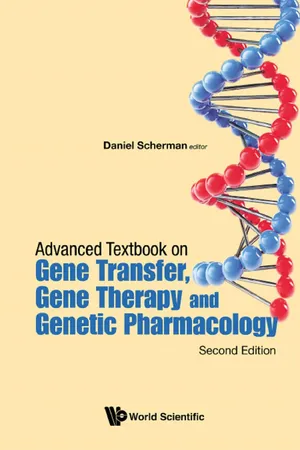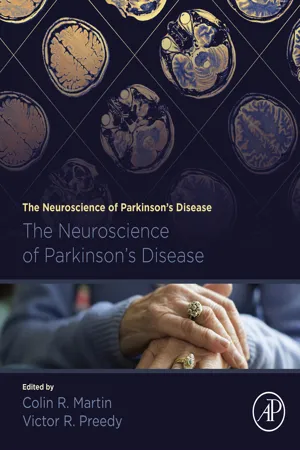Biological Sciences
Lentivirus Vectors
Lentivirus vectors are a type of gene delivery system derived from lentiviruses, which are a family of retroviruses. They are commonly used in gene therapy and gene editing applications due to their ability to efficiently deliver genetic material into a wide range of cell types, including non-dividing cells. Lentivirus vectors are particularly valuable for their stable and long-term gene expression capabilities.
Written by Perlego with AI-assistance
Related key terms
4 Key excerpts on "Lentivirus Vectors"
- eBook - ePub
Advanced Textbook on Gene Transfer, Gene Therapy and Genetic Pharmacology
Principles, Delivery and Pharmacological and Biomedical Applications of Nucleotide-Based Therapies
- Daniel Scherman(Author)
- 2013(Publication Date)
- ICP(Publisher)
PART II VECTORS AND GENE DELIVERY TECHNIQUESPassage contains an image 8 γ-RETROVIRUS- AND LENTIVIRUS-DERIVED VECTORS FOR GENE TRANSFER AND THERAPY
Caroline Durosa and Odile Cohen-Haguenauer8.1Introductiona ,bViral vectors can be manipulated in vitro to modify their genomes in order to insert a gene of interest. Intrinsic viral cycle properties, such as DNA importation into the nucleus and its expression, are therefore used to deliver the transgene to target cells. The major advantage of viral vectors derived from retroviruses is the integration of the transferred transgene into the chromosome of the host cell, which may enable long-lasting transgene expression, not only in the transduced target cell, but also in all offspring cells after cell division.8.2The Concept: Designing Retrovirus-Based Vectors 8.2.1Starting From the Knowledge of Helper Retrovirus BiologyRetroviruses are composed of oncoviruses, lentiviruses and spumaviruses. Oncoretroviruses can only infect dividing cells, because they require the disruption of the nuclear membrane for the viral genome to get into the nucleus, whereas lentiviruses can also infect non-dividing cells. Oncoretroviruses and lentiviruses are also first-choice vectors because they can be manipulated to obtain defective, non-replication-competent viruses in the target cells. Retroviruses are enveloped viruses with positive RNA, two identical RNAs being encapsidated in the viral particle. Their genome is composed, on one hand, of 5' and 3' long terminal repeat (LTR) regulatory sequences, and on the other hand of coding sequences for structural and enzymatic proteins: group-specific antigen (gag), polymerase (pol), envelope (env) and accessory proteins (Fig. 8.1 ).FIGURE 8.1 Organization of the γ-retrovirus genome.The LTR consists of replication-initiation sequences, transcription-and translation-regulatory sequences (U3 and U5), as well as sequences necessary for transgene integration (R: repeated sequences). The encapsidation/packaging signal (φ) is located just downstream of the 5' LTR encompassing the 5' part of the gag sequences. Gag encodes nucleocapsid proteins and internal peptides. Pol encodes proteins required for replication and viral genes’ expression (protease, reverse transcriptase and integrase). Env encodes envelope proteins (Fig. 8.2 - eBook - ePub
Advanced Textbook on Gene Transfer, Gene Therapy and Genetic Pharmacology
Principles, Delivery and Pharmacological and Biomedical Applications of Nucleotide-Based Therapies
- Daniel Scherman(Author)
- 2019(Publication Date)
- WSPC (EUROPE)(Publisher)
PART II
VECTORS AND GENE DELIVERY TECHNIQUES
Passage contains an image
9
γ-RETROVIRUS- AND LENTIVIRUS-DERIVED VECTORS FOR GENE TRANSFER AND THERAPY
Caroline Durosa and Odile Cohen-Haguenauera ,b ,c9.1Introduction
Viral vectors can be manipulated in vitro to modify their genomes in order to insert a gene of interest. Intrinsic viral cycle properties, such as DNA importation into the nucleus and its expression, are therefore used to deliver the transgene to target cells. The major advantage of viral vectors derived from retroviruses is the integration of the transferred transgene into the chromosome of the host cell, which may enable long-lasting transgene expression, not only in the transduced target cell, but also in all offspring cells after cell division.9.2The Concept: Designing Retrovirus-Based Vectors
9.2.1Starting From the Knowledge of Helper Retrovirus Biology
Retroviruses are composed of oncoviruses, lentiviruses and spumaviruses. Oncoretroviruses can only infect dividing cells, because they require the disruption of the nuclear membrane for the viral genome to get into the nucleus, whereas lentiviruses can also infect non-dividing cells. Oncoretroviruses and lentiviruses are also first-choice vectors because they can be manipulated to obtain defective, non-replication-competent viruses in the target cells. Retroviruses are enveloped viruses with positive RNA, two identical RNAs being encapsidated in the viral particle. Their genome is composed, on one hand, of 5′ and 3′ long terminal repeat (LTR) regulatory sequences, and on the other hand of coding sequences for structural and enzymatic proteins: group-specific antigen (gag), polymerase (pol), envelope (env) and accessory proteins (Fig. 9.1 ).FIGURE 9.1 Organization of the γ-retrovirus genome.The LTR consists of replication-initiation sequences, transcription- and translation-regulatory sequences (U3 and U5), as well as sequences necessary for transgene integration (R: repeated sequences). The encapsidation/packaging signal (φ) is located just downstream of the 5′ LTR encompassing the 5′ part of the gag sequences. Gag encodes nucleocapsid proteins and internal peptides. Pol encodes proteins required for replication and viral genes’ expression (protease, reverse transcriptase and integrase). Env encodes envelope proteins (Fig. 9.2 - eBook - ePub
- Colin R Martin, Victor R Preedy, Colin R. Martin, Victor R. Preedy(Authors)
- 2020(Publication Date)
- Academic Press(Publisher)
The infectious cycle of viruses initiates by binding to a host cell. Binding specificity to target cells is called tropism and is mediated by capsid proteins, or for enveloped viruses, by proteins integrated into the envelope. Subsequently, virus particles enter the cells, usually by means of endocytosis or micropinocytosis, followed by release from endocytic vesicles and decapsidation. Once inside the cytoplasm, nucleic acid of the virus can be either directly translated or reverse-transcribed to DNA or transported into the nucleus where it can either integrate into the genome or stay episomal and be transcribed by the host machinery (Grinevich et al., 2016) Integration of viral DNA into the host genome warrants stable expression, especially in dividing cells; however, it carries the risk of causing insertional mutagenesis, as viral DNA tends to integrate into transcriptionally active sites, which might be those of tumor-suppressor genes, or randomly integrated viral promoter might drive the expression of nearby oncogenes. By the creation of viral vectors, where the genetic material encoding the viral proteins responsible for virus replication is replaced by genes of interest, it is possible to create a nonreplicating “molecular syringe” that efficiently injects nucleic acid into host cells. Two types of viral vectors—AAV vectors and lentiviral vectors—have so far been utilized in clinical trials aimed at treating PD. AAV vectors are perhaps the most studied viral vectors for gene delivery in both laboratory and clinical settings. AAVs are single-stranded DNA viruses. Their virion (virus particle) consists of a small nonenveloped capsid, ∼20 nm in diameter and packaging 4.7 kb of genome (Table 35.1). AAVs rely on helper viruses such as adenoviruses to complete their replication cycles. Safety is one of the main advantages of AAVs in gene therapy, as they are not pathogenic, and in most cases are nonintegrating viruses (only ∼1% of AAV genomes integrate) - eBook - ePub
The World Scientific Encyclopedia of Nanomedicine and Bioengineering I
Nanotechnology for Translational Medicine: Tissue Engineering, Biological Sensing, Medical Imaging, and Therapeutics(A 4-Volume Set)
- Yu Cheng, Jia Huang, Yarong Liu, Pin Wang, Bingbo Zhang(Authors)
- 2016(Publication Date)
- WSPC(Publisher)
1 Gene therapy, which is the delivery of genetic material into cells for expression of specific genes, has shown success in a number of monogenic and complex genetic disorders. Gene delivery vehicles used for therapeutic applications can be divided into two classes: viral and nonviral vectors. A major focus of current gene therapy involves disabling the pathological effects of viral vectors. Although they are challenged by the pre-existing immunity of their hosts, viral vectors maintain an advantage over nonviral vectors due to their established gene delivery mechanisms. Common viral vectors that have been studied for potential clinical applications include retroviral vectors, lentiviral vectors, adenoviral vectors and adeno-associated virus (AAV) vectors, which is the focus of this chapter.AAV vectors have gained popularity for gene therapy applications mainly because of their nonpathogenicity and ability to deliver genes to a site-specific location in the host chromosome. Moreover, AAVs have a native tropism to a number of clinically relevant tissues such as the liver, muscles and neuronal tissues, which makes it a promising gene delivery vehicle for therapeutic gene therapy. However, the progress of AAV engineering has been hindered by problems concerning its broad native tropism, pre-existing host immunity and impaired intracellular trafficking. Since the viral capsid protein is the major contributor to these processes, multiple studies have focused on developing strategies to chemically or genetically modify the capsid surface to overcome the systemic challenges. This chapter addresses the various capsid modification strategies adopted for AAV engineering to enhance targeting and transduction efficiency.2.AAV Serotypes
The AAV is a parvovirus initially discovered as a contaminant in simian adenoviral type 15 (SV15) preparations. Over a hundred AAV clones have since been detected in primate genomes. The small, DNA containing particles were first observed in a pooled harvest of rhesus-monkey-kidney-cell (RMK) cultures infected with SV15. Experiments showed that AAV could only replicate in RMK cultures when it is coinfected with SV15, suggesting that AAV particles behave as defective viruses because they cannot replicate in the absence of adenoviruses (Ad).2 Five primate AAVs, which include AAV1–6 except for AAV5, were found as contaminants in preparations of adenovirus.3 In order to isolate new serotypes, laboratories used polymerase chain reaction (PCR) to isolate AAV7–11 and many other clones from human and nonhuman primate genomes.4 −6
Learn about this page
Index pages curate the most relevant extracts from our library of academic textbooks. They’ve been created using an in-house natural language model (NLM), each adding context and meaning to key research topics.



